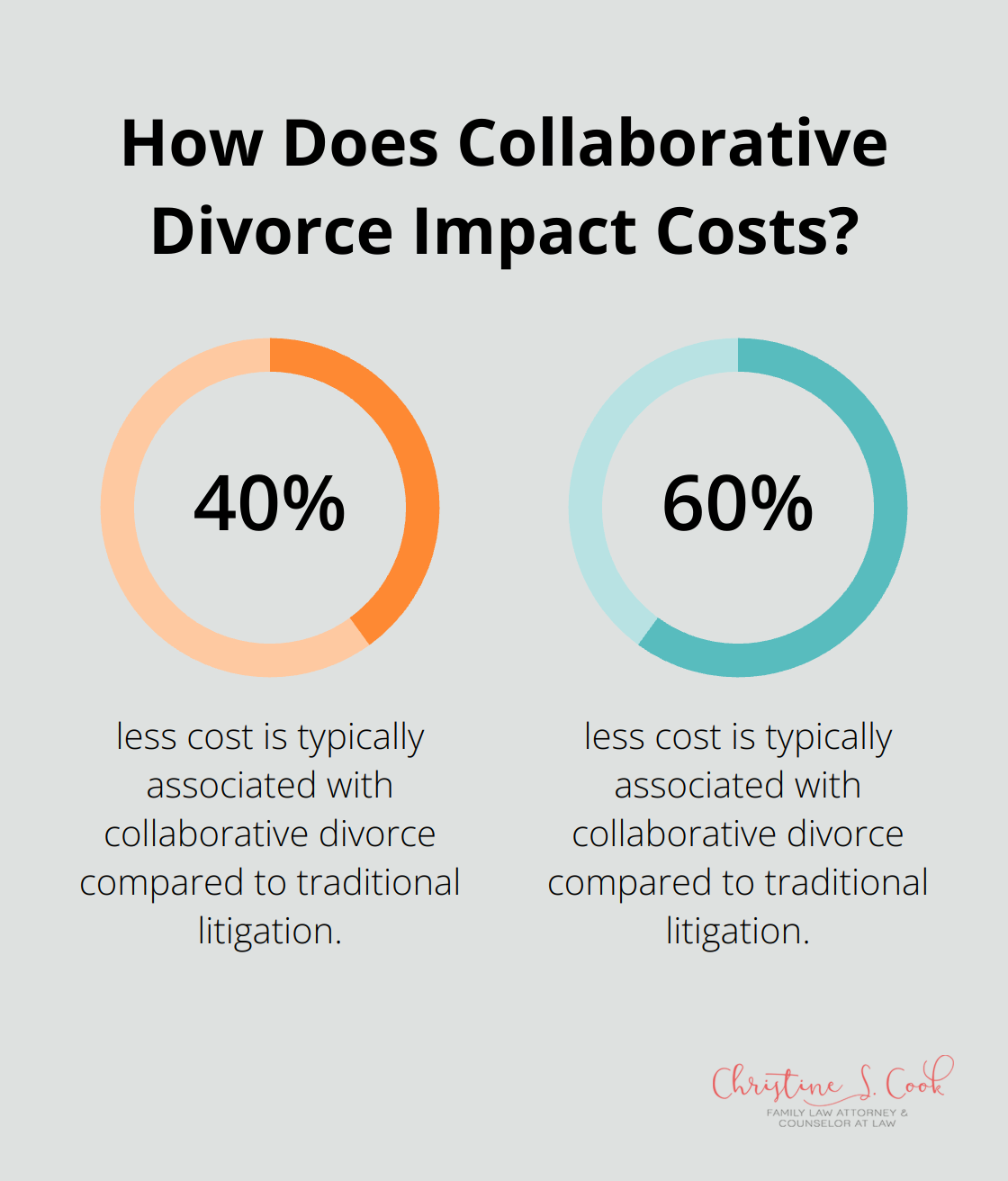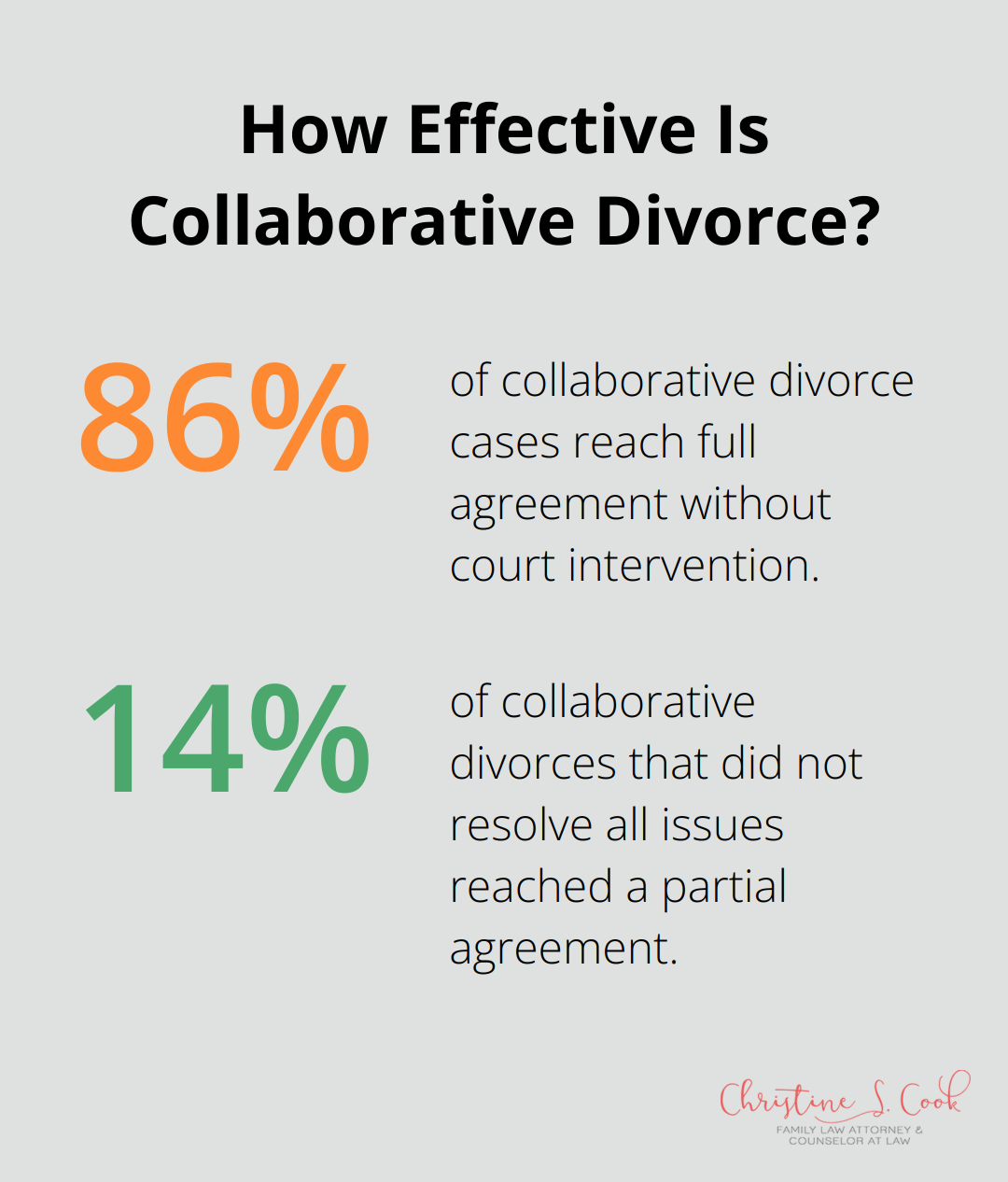At Christine Sue Cook, LLC, we understand the challenges couples face during divorce. That’s why we’re committed to exploring alternative approaches that prioritize cooperation and mutual respect.
The main purpose of the Collaborative Divorce Project is to provide a more amicable and less adversarial way to end a marriage. This innovative method aims to reduce stress, save time and money, and protect the well-being of all family members involved.
Collaborative divorce represents a progressive method for marriage dissolution that emphasizes cooperation and mutual respect. This process resolves disputes without court intervention, which saves time, money, and reduces emotional stress for all parties involved.
In collaborative divorce, each spouse retains an attorney trained in collaborative law. These attorneys collaborate (rather than compete) to achieve a fair settlement. The process often includes other professionals such as financial advisors and child specialists who provide neutral expertise. This team approach ensures comprehensive and fair handling of all divorce aspects.
The collaborative process rests on several fundamental principles:
Collaborative divorce stands in stark contrast to traditional divorce litigation. While litigation often creates adversaries in court, collaborative divorce keeps decisions in the couple’s hands. A study by the International Academy of Collaborative Professionals found that 94% of collaborative cases reach full resolution without court intervention. This approach not only reduces costs but also preserves relationships (particularly beneficial when children are involved).
Families often find that collaborative divorce allows them to maintain dignity and control throughout the process. This approach can lead to more satisfying outcomes, as it takes into account the unique needs of each family situation. The focus on open communication and problem-solving can also set a positive tone for future interactions, especially important for co-parenting relationships.

As we move forward, let’s explore the specific benefits that collaborative divorce offers to all parties involved in the process.
Collaborative divorce puts the emotional health of all family members at the forefront. This process fosters open communication and problem-solving, which minimizes the adversarial nature often associated with divorce. Couples work through their issues in a supportive environment, which reduces long-term emotional trauma for both adults and children.
The collaborative approach typically costs 40% to 60% less than traditional litigation (according to a report by the International Academy of Collaborative Professionals). This substantial cost reduction results from avoiding lengthy court battles and using shared experts. For instance, instead of each party hiring separate financial advisors, a neutral financial specialist provides unbiased guidance to both spouses. This strategy not only saves money but also promotes transparency and fairness in financial settlements.
Unlike court proceedings (which become part of the public record), collaborative divorce maintains confidentiality. This privacy protection proves particularly valuable for high-profile individuals or those with sensitive personal or financial information. The collaborative process ensures discretion throughout the divorce proceedings.
The collaborative approach often leads to faster resolutions compared to traditional litigation. While a litigated divorce can take years to finalize, collaborative divorces typically resolve within 4 to 8 months. This efficiency allows couples to move forward with their lives more quickly, reducing the prolonged stress and uncertainty associated with drawn-out legal battles.
Collaborative divorce allows for creative and customized solutions that address the specific needs of each family. The process encourages both parties to think outside the box and find mutually beneficial arrangements. This flexibility often results in more satisfying outcomes that traditional court-imposed solutions might not achieve.

As we explore the key components of the collaborative process, you’ll see how these benefits come together to create a more positive divorce experience for all involved parties.
Collaborative divorce relies on a team of professionals who work together to achieve a fair and amicable resolution. The collaborative process allows couples to resolve complex issues with tailor-made solutions rather than leaving critical decisions to a judge. Each spouse retains an attorney trained in collaborative law. These attorneys cooperate rather than compete. Financial advisors provide neutral expertise on asset division and long-term financial planning. Child specialists offer insights on co-parenting arrangements and address the emotional needs of children during the transition.
The core of the collaborative process consists of a series of four-way meetings. These meetings include both spouses and their attorneys, with other professionals joining as needed. During these sessions, all parties identify issues, brainstorm solutions, and negotiate agreements.

A study revealed that 86% of collaborative cases reach full agreement without court intervention. Of collaborative divorces that did not resolve all issues, the parties did reach a partial agreement in 14 percent of the cases.
Full disclosure forms a fundamental principle of collaborative divorce. All parties share financial information and relevant documents openly. This transparency builds trust and allows for more informed decision-making.
The collaborative agreement (signed at the beginning of the process) includes a disqualification clause. This clause requires attorneys to withdraw if the case moves to litigation, which provides a strong incentive for all parties to remain committed to the collaborative process.
One of the most significant advantages of collaborative divorce is the ability to craft personalized solutions. Unlike court-imposed decisions, collaborative agreements can be tailored to the unique needs of each family. For example, a couple with a family business might develop a co-ownership arrangement that wouldn’t be possible in traditional litigation.
Neutral experts play a crucial role in the collaborative process. These professionals (such as financial advisors, child specialists, and mental health professionals) provide unbiased information and guidance to both parties. Their involvement helps reduce conflict and ensures that decisions are based on accurate information and expert advice.
The main purpose of the Collaborative Divorce Project is to transform divorce into a constructive experience. This approach prioritizes open communication, mutual respect, and cooperative problem-solving. Families benefit from reduced conflict, better emotional outcomes for children, and more sustainable agreements tailored to their unique needs.

Collaborative divorce offers significant financial advantages beyond immediate cost savings. Couples preserve more assets and create stable financial futures by finding mutually beneficial solutions. The process also teaches valuable communication and problem-solving skills that serve families well in future challenges.
Christine S. Cook, LLC understands the complexities of divorce and the importance of amicable solutions. Our team guides clients through the collaborative process with compassion and expertise. For those seeking a positive approach to divorce, Christine S. Cook, LLC provides the knowledge and support needed to navigate this process successfully.
